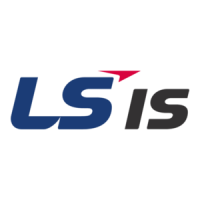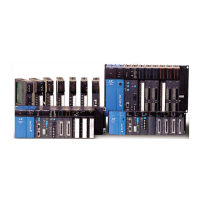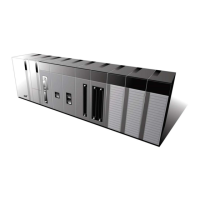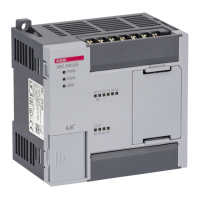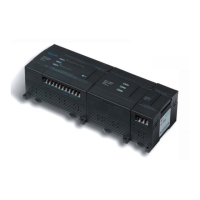
Do you have a question about the LS Industrial Systems GLOFA GM7U Series and is the answer not in the manual?
| Series | GLOFA GM7U |
|---|---|
| Type | PLC |
| Communication | Ethernet, RS-232, RS-485 |
| Operating Temperature | 0°C to 55°C |
| Humidity | 5 to 95% RH, non-condensing |
| Power Supply | 24V DC |
| Weight | Varies depending on module (refer to specific model) |
| Programming Language | LD, SFC, ST, IL, FBD |
Guidelines for preventing serious problems during PLC module design and operation.
Measures to ensure safe and correct installation of the PLC unit.
Instructions for safe and correct wiring of the PLC system components.
Safety guidelines for starting up and maintaining the PLC system.
Guidelines for the safe and environmentally responsible disposal of the product.
Provides an overview of the manual's structure and content for the GLOFA-GM7U series.
Details the key features and capabilities of the GLOFA-GM7U series PLC.
Defines important terms and concepts used throughout the manual.
Describes the basic, computer link, and network system configurations for the GLOFA-GM7U series.
Lists and describes the functional models of the GLOFA-GM7U series.
Provides the general specifications and environmental requirements for the GLOFA-GM series.
Identifies and describes the components and indicators of the main PLC units.
Details the various expansion modules available for the PLC system.
Describes the specifications and functions of special purpose modules.
Explains the specifications and usage of communication interface modules.
Details the electrical specifications for AC and DC power supplies.
Lists the general specifications for the CPU module, including memory and I/O.
Explains the PLC's operation methods, scan time, and watchdog timer functions.
Covers program configuration, execution procedures, tasks, and error handling.
Describes the different operating modes (RUN, STOP, PAUSE, DEBUG) and their functions.
Details functions like RESTART modes, self-diagnosis, and remote operations.
Explains the structure and capacity of program and data memory.
Describes how I/O numbers are allocated to modules for addressing.
Explains the structure and usage of the built-in communication setting switch.
Details the structure and usage of the external memory module for program backup.
Describes the specifications, structure, and usage of the Real-Time Clock module.
Provides general specifications for digital inputs and outputs, including relay output life.
Details specifications, circuit diagrams, and wiring for digital input modules.
Details specifications, circuit diagrams, and wiring for digital output modules.
Provides specifications, circuit diagrams, and wiring for expansion modules.
Details specifications, circuit diagrams, and wiring for relay output expansion modules.
Details specifications, circuit diagrams, and wiring for TR output expansion modules.
Describes the usage of built-in PLC functions.
Explains the specifications and handling of the built-in high-speed counter (HSC).
Details the minimum input pulse width and operation of the pulse catch function.
Explains how to use the input filter to improve system reliability in noisy environments.
Provides information on the built-in PID control function of the GM7U main unit.
Details the specifications and data registers for special modules.
Describes the performance specifications of the analog mixture module.
Provides performance specifications for the analog input module.
Details the performance specifications of the analog output module.
Explains the performance specifications and function of the analog timer module.
Details the performance specifications of the RTD input module.
Covers the 2-axis positioning function for servo and stepping motor control.
Explains position control, speed control, and operation patterns for positioning.
Details positioning parameters like acceleration, deceleration, and origin return.
Describes positioning instructions such as POSIST, POSJOG, POSCTR, POSPRS.
Lists system flags and error codes related to positioning operations.
Provides wiring diagrams for connecting servo and stepping motor drives.
Explains the dedicated communication function for GM7U main units.
Details methods for composing systems using GM7U built-in communication.
Describes the base format for communication frames (Request, ACK, NAK).
Lists the commands used for reading, writing, and status monitoring.
Specifies the data types (Bit, Byte, Word, Double Word) for device communication.
Explains how to execute commands for reading and writing PLC device memory.
Details built-in communication systems between GM7U units (master/slave).
Explains how to define and use custom communication protocols.
Covers Modbus communication, including ASCII and RTU modes.
Explains communication without a defined protocol for unfixed data.
Describes remote connection methods using Cnet I/F and communication modules.
Provides guidelines for installing the PLC unit and its environment requirements.
Details the environmental requirements to ensure system reliability.
Explains instructions for handling the main unit and expansion modules.
Describes the procedure for connecting expansion modules to the main unit.
Provides wiring instructions for the PLC system.
Details the instructions for connecting the power supply to the PLC.
Explains wiring procedures for connecting input and output devices.
Provides guidelines for grounding the PLC to minimize noise.
Lists the recommended cable specifications for various connections.
Covers periodic inspection items and countermeasures for the I/O module.
Details the inspection points and judgments for daily checks.
Outlines items to check during periodic inspections and corrective actions.
Provides basic instructions for identifying and resolving system faults.
Explains procedures for determining causes and corrective actions for errors.
Step-by-step guide for troubleshooting when the POWER LED is off.
Corrective actions for troubleshooting when the ERROR LED is flickering.
Procedure for addressing issues when the RUN LED is turned off.
Troubleshooting steps for when I/O modules are not operating correctly.
Procedure for resolving issues preventing program writing to the CPU.
A questionnaire to gather information for contacting the service center.
Illustrates common troubles with circuits and their corrective actions.
Describes possible input circuit troubles and their solutions.
Describes possible output circuit troubles and their corrective actions.
Lists error codes, causes, corrective actions, and operation status.
Details connection options, including communication port settings.
Specifies directories for creating files in GMWIN.
Configures options for monitoring variables and debugging programs.
Sets compile types and clears M area at stop.
Covers essential parameters for PLC operation, memory allocation, and restart modes.
Details parameters for PID auto-tuning and PID control.
Explains parameters for positioning functions like acceleration and speed.
Details parameters for configuring high-speed counters.
Lists and describes user-defined flags for program control.
Details system error flags and their descriptions.
Lists system warning flags and their descriptions.
Provides detailed system error and warning flag information.
Lists flags related to system operation status and connection.
Describes the status information of the operation mode change switch.
Lists available functions with their size and processing speed.
Lists available function blocks with their size and processing speed.
Provides external dimensions for the base PLC unit.
Provides external dimensions for the standard type extension modules.
